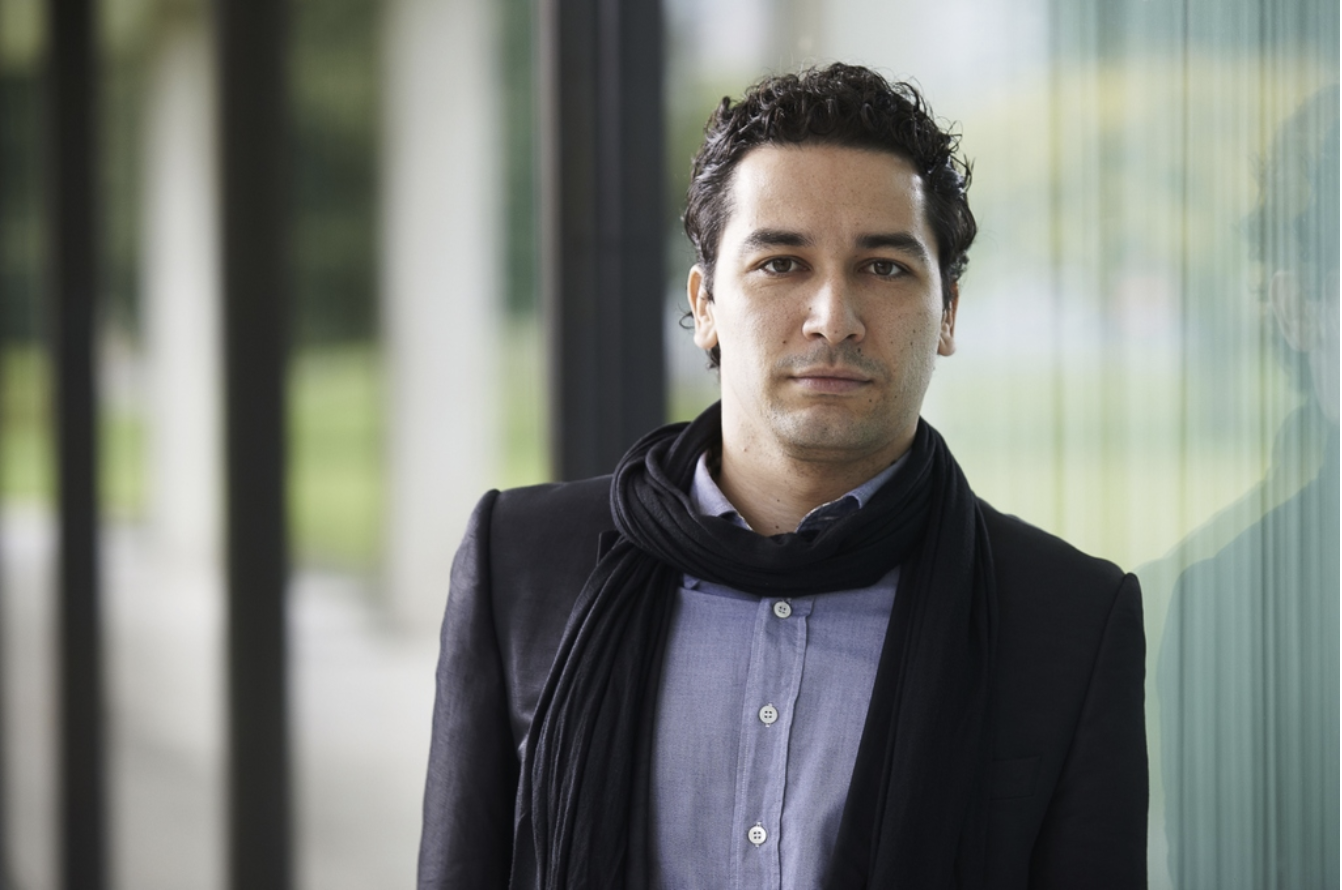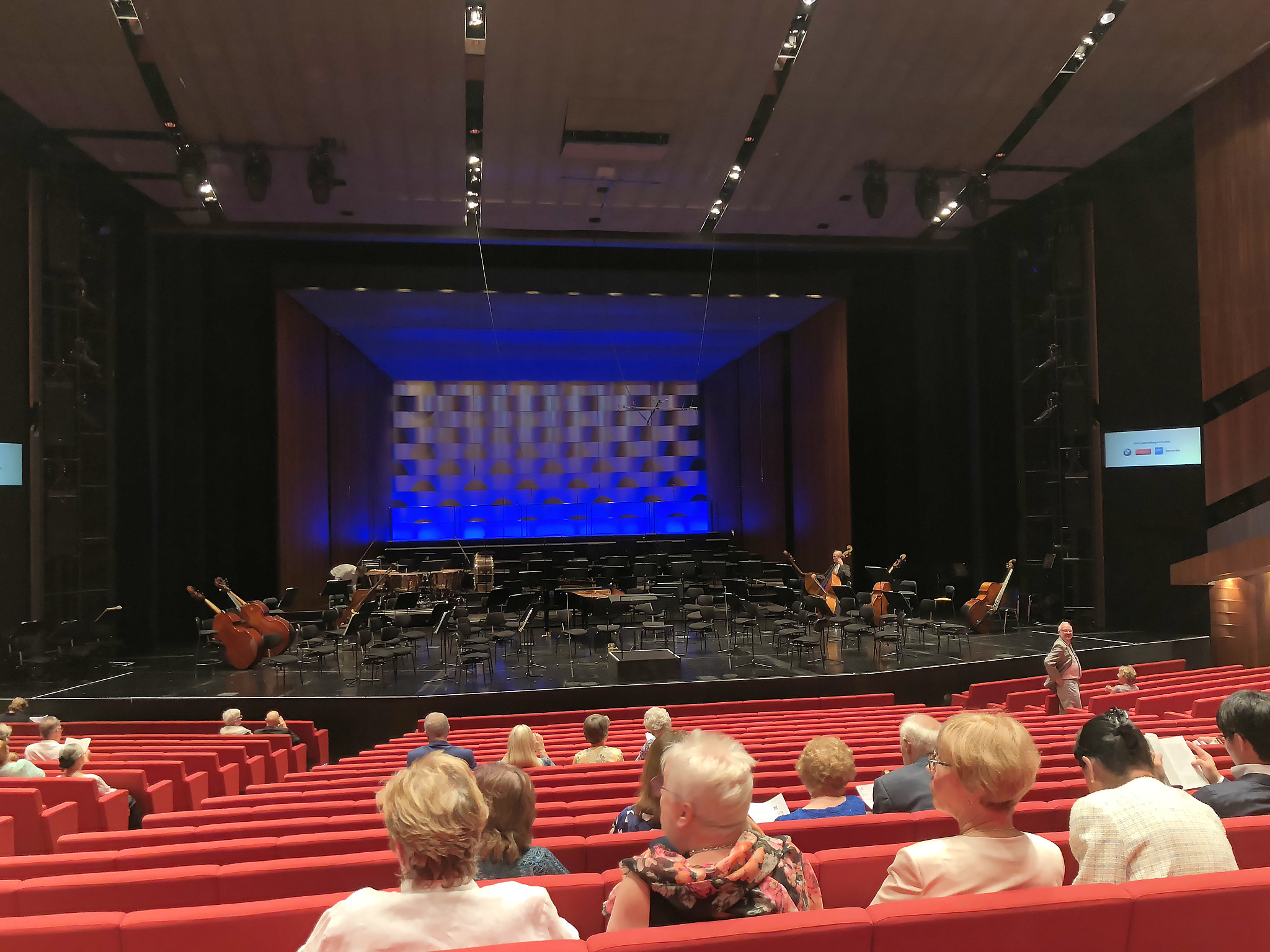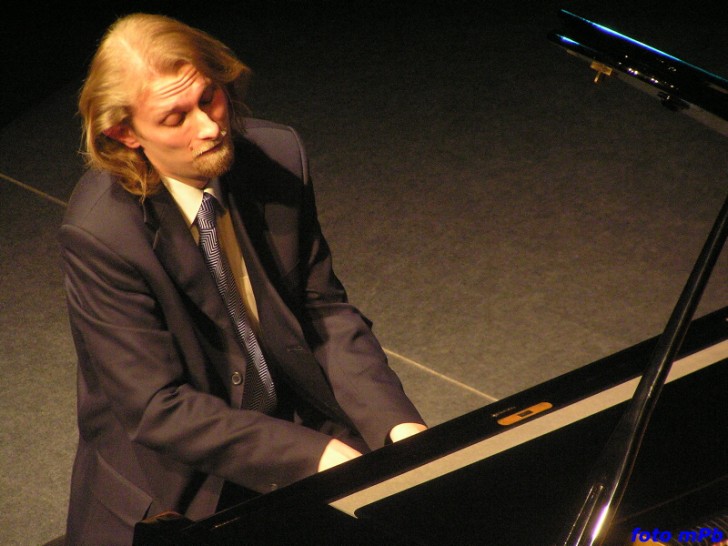Kahánek, Orozco-Estrada / Vienna Symphony Orchestra
Martinů / Dvořák
Festspielhaus, Bregenz, 2018-07-23

2018-08-01 — Original posting
Slawische und akustische Herausforderungen — Zusammenfassung
Ein Konzert mit gemischtem Erfolg. Der Bregenzer Konzertsaal (auch Ersatzspielstätte für Oper) scheint nicht ideal für das Doppelkonzert von Bohuslav Martinů, auch bei einer technisch exzellenter Ausführung wie hier. Musikalisch war dies der Höhepunkt des Abends. Der interpretatorische und technische Höhepunkt war für mich hingegen das Te Deum von Dvořák, dank der Leistung der Prager Philharmonischen Chors. Bei Dvořáks Neunter Sinfonie (“Aus der Neuen Welt”) hatte ich hingegen den Eindruck, dass Andrés Orozco-Estrada mit dem Bregenzer Saal noch zu wenig vertraut war, noch herausfinden muss, wie das Orchester am besten in die Theater-Akustik eingepasst werden kann und sollte.
Table of Contents
Introduction
In summer, in the festival season, the Vienna Symphony Orchestra (see also Wikipedia) spend several weeks in their second home in Bregenz. They stand at the core of the Bregenzer Festspiele (Bregenz Festival), as Orchestra in Residence. The ensemble serves as opera orchestra for performances on the lakeside stage (a stage on the lake, actually). This year, the opera performances feature the opera “Carmen” by Georges Bizet (1838 – 1875). In each festival the orchestra also performs three symphonic concerts in the Festspielhaus, typically with guest conductors.
From a recent concert in Zurich, on 2018-06-09, I knew that the orchestra is in excellent shape, so I was excited and curious about this one. However, this time, the ensemble was not playing under its chief conductor, Philippe Jordan (*1974). The “Holder of the baton” was the Columbian Andrés Orozco-Estrada (*1977, see also Wikipedia). In 2021, Orozco-Estrada will take over the position of chief conductor of the VSO from Philippe Jordan. This was Orozco-Estrada’s first appearance in Bregenz.
Program
For this first concert in the Bregenz season 2018, the program featured three works:
- Bohuslav Martinů’s “Double Concerto for Two String Orchestras, Piano and Timpani”,
- Antonín Dvořák’s “Te Deum”, op.103, and
- Dvořák’s Symphony No.9 in E minor, “From the New World”
I’ll mention the soloists and the choir in the respective sections below.
The Venue
The lakeside opera stage and the Festspielhaus Bregenz are one and the same, i.e., part of a single building complex (which is also a conference facility). The Festspielhaus (the actual “house”) serves as alternative opera stage in the case of bad weather, i.e., it actually is an opera theater with 1656 seats, orchestra pit and a stage with the necessary facilities. The large auditorium is optimized for best visibility from all seats, the acoustics are dry, without substantial reverberation. This is typical for opera and theater venues.
For this concert, a podium at the level of the stage took the place of the orchestra pit, the Vienna Symphony Orchestra filled the part of the podium in the auditorium, as well as a part of the stage behind the proscenium arch.
Concert & Review
Martinů: Double Concerto for Two String Orchestras, Piano and Timpani, H.271
The Czech composer Bohuslav Martinů (1890 – 1959) was a prolific composer, creator of 6 symphonies, 15 operas, 14 ballet scores, and numerous other works—see Wikipedia. His Double Concerto for Two String Orchestras, Piano and Timpani, H.271, was commissioned by the Swiss conductor and patron Paul Sacher (1906 – 1999). Martinů completed the work in September 1938. The idea behind this work is an interesting one. The “double” does not refer to piano and timpani as two solo instruments, but rather to the two orchestras. The two string orchestras operate in a dialog, as complementary voices, They often interacted in canon-like fashion, passing on motifs, themes, melody fragments.
Consequently, with the exception of the middle movement, the piano is not so much of a solo instrument, but rather assumes the role of an acoustic mediator between the two string bodies. It still fulfills a pivotal role by helping the coordination, reinforcing the rhythmic structure. The concerto features three movements:
- Poco Allegro — Allegro
- Largo — Poco moderato — Lento — Andante — Andante moderato — Largo — Adagio
- Allegro — Vivo — Poco moderato
Martinů’s music is readily accessible to today’s ears (and sure was already at the time of the composition). The beginning of the concerto bears strong reminiscences of the ballets that Igor Stravinsky (1882 – 1971) composed for Sergei Diaghilev’s Ballets Russes. However, the music soon adopts the composer’s personal idiom. The concerto also bears strong influences from Martinů’s concerns and worries about the ongoing situation in his home country.
The Performance
The idea of the concerto sounds conclusive. Realizing it in a concert, however, is facing some serious challenges. It starts with arranging the musicians on the podium. The two string orchestras were facing each other on opposite sides of the stage, in the auditorium. The piano resided between the two string bodies, without lid, the pianist facing the audience, with direct view to Andrés Orozco-Estrada. The percussion instruments (Michael Vladar) were located in the rear left.
Martinů’s concerto is rhythmically demanding, if not challenging, especially for the conductor. The latter needs to control both string orchestras directly, keep an eye on all voices at all times. From behind the lid of a concert grand in conventional arrangement, this is hardly doable. The above arrangement seems to serve all these needs, and it also offers the best possible connection between pianist and conductor.
In this work, Orozco-Estrada conducted without baton. Both hands were needed to control the two orchestras with equal attention. There was no relying upon the help of a single concertmaster to keep the orchestras aligned!
The pianist in this performance was Ivo Kahánek (*1979, see also Wikipedia). He was playing from sheet music. For the most part of the performance, he was focusing on the music stand and rarely seemed to establish direct visual contact with Andrés Orozco-Estrada, rather worked via peripheral vision.
Challenges
Technically, the above arrangement worked well. Orchestra, Andrés Orozco-Estrada and the two soloists exhibited no weaknesses. The coordination within the orchestra was perfect, string sound and articulation left very little, if anything, to wish for.
Still, I wasn’t entirely happy with the result. Was it the dry theater acoustics? Or maybe the geometry of the venue (my wife and I were sitting in row 19)? It seemed hard to discern the two orchestral parts. Both spatially and in sound the two string bodies did not appear as well-enough separated entities. One may attribute some of this to the composition, as the interaction between the orchestras is very close, not the same as in many baroque compositions for multiple, separate orchestras.
Worse, however: parts of the piano sound seemed to get lost in the depth of the stage. In the absence of the lid, the concert grand did not project (at least not well enough) into the audience. With this, the sound of the piano often was drowning in the string sound. And, where one did hear the piano, its sound sometimes lacked definition, presence, volume, clarity and detail.
I. Poco Allegro — Allegro
Despite the above (mainly) acoustic challenges, the performance still was an interesting and enjoyable experience. The fast movements were rhythmically enthralling.
II. Largo — Poco moderato — Lento — Andante — Andante moderato — Largo — Adagio
However, there are also episodes when the music feels uneasy. One example is the climax in the first part of the middle movement. That’s likely expressing the composer’s anxieties. Often, the music appears to work towards a harmonic resolution (a cadenza, ideally), but Martinů doesn’t let that happen.
The Andante part of the middle movement features an interesting piano cadenza in two parts, separated by a 4-bar Lento interjection. That is the only real piano solo in the concerto. Ivo Kahánek took the Andante fairly fluent. This way, the listener never lost the feel for the basic pulse, even though the two hands play parts that are seemingly incoherent. That latter aspect, the apparent, complete rhythmic independence of the two hands (a complex mix of odd and even rhythms, syncopes, rhythmic shifts) was hardly recognizable here: I think that ideally, this segment should almost sound aleatoric. One minor quibble: the piano was a tiny bit late with the accents in the Andante moderato section.
III. Allegro — Vivo — Poco moderato
Kahánek was agile in the accents. Overall, the performance seemed to focus on the musical flow, certainly was not overly analytical.
A smaller orchestra might have helped the transparency and the sound balance of the performance. However, in a large venue such as this one, this might have led to different acoustic challenges?
Rating: ★★★
Dvořák: Te Deum, op.103, B.176
The Te Deum, op.103, B.176, is a composition that Antonín Dvořák (1841 – 1904) wrote 1892, on the occasion of the 400th anniversary of the discovery of the Americas by Christopher Columbus (1451 – 1506). Dvořák had accepted the invitation to lead the National Conservatory of Music in New York for two years. Time was short, and as no better text was at hand, the composer agreed to writing a Te Deum. Dvořák completed the work within one month, the composition premiered at Carnegie Hall, with 250 singers in the choir. The Te Deum comes in four movements, all performed attacca:
- Allegro moderato, maestoso (choir) — Un poco meno mosso (soprano/choir TB) — Tempo I (choir) —
- Lento maestoso (bass) — Un poco più mosso (choir, SA) — Tempo I, Meno mosso (bass) — Un poco più mosso (choir, TB) —
- Vivace (choir) —
- Lento (soprano/choir — soprano/bass) — Poco più mosso (choir)
The composition may feel rather compact, catchy and bold (too bold, maybe?). Already the opening of the composition is fairly pithy, maybe too pithy, easily memorable, with the danger of turning into an earworm. This sure was in line with the purpose of the piece, which wasn’t primarily religious. Johannes Brahms (1833 – 1897) allegedly commented that “The work seems to be intended for the destruction of Vienna and Berlin by the Bohemian forces—and it seems suitable to achieve that goal.”
The Artists
For the other works in this concert, Orozco-Estrada had the orchestra now performing in standard, romantic configuration. The violins were on the left, followed by cellos, violas on the right. The wind instruments filled the space between the strings and the 80 professional singers of the Prague Philharmonic Choir in the rear of the stage, in a block arrangement, (from left) S–A–T–B. Andrés Orozco-Estrada now switched to conducting with baton. On the left-hand side of the conductor’s podium stood the Slovenian soprano Mojca Bitenc, on his right the Polish bass (rather: baritone) Dariusz Perczak.
The Performance
I. Allegro moderato, maestoso — Un poco meno mosso — Tempo I —
Already the opening made it clear: the Prague Philharmonic Choir is a high-class professional choir. Its sound was full, homogeneous, equilibrated, diction and vocalization very good. Flawless of course the coordination, the coloraturas clear, the heights excellent, especially with the soprano and the tenor voices. The vocal volume was impressive, the dynamic range and control astounding, as was the overall sonority. Even among professional opera choirs I give this ensemble a very high ranking.
The middle part of the movement (Sanctus, sanctus) features a solo for the soprano voice, with ppp accompaniment by the male choir voices. It was astounding to observe the choir’s pianissimo sonority, out of the depth of the opera stage! Mojca Bitenc exhibited an impressive, dramatic voice with beautiful timbre and good projection. However, the vibrato occasionally seemed a bit on the strong side, especially in lyrical segments. Also, with high notes (loud ones, in particular), she had a tendency to start with a lower pitch, and occasionally, she tended to slur some notes.
II. Lento maestoso — Un poco più mosso — Tempo I, Meno mosso — Un poco più mosso —
Also the voice of baritone Dariusz Perczak featured a nice timbre, as well as good volume in the baritone register. His vibrato was natural, his voice control very good. Sadly, Dvořák’s composition is rather for bass-baritone, and in the low register, Perczak’s volume rapidly dropped off. The singer underlined the operatic character of his voice and his part (Tu Rex gloriae) with opera-style arm gestures. These may be acceptable in the U.S.—here, in a European context, I found them somewhat strange, exaggerated.
In the Un poco più mosso parts (Te ergo quaesumus), the acoustics put the choir (pp) at a disadvantage: relative to the orchestra, it deserved a bit more presence. Fortunately, this did not apply to the remainder of the composition:
III. Vivace —
Here, in the Aeterna fac cum Sanctis tuis in gloria munerari, the balance was again right, the choir simply excellent: impressive, dramatic, enthralling in the mf / f segments, but equally good also in the pp, the performance transparent, thanks to the composer’s diligent disposition.
IV. Lento — Poco più mosso
My main quibble in the last part (Dignare, Domine) was that the soprano was essentially covering the baritone voice in the duets. And again, the vibrato was on the heavy side, the voice maybe too dramatic. I picture the soft, lyrical parts with a more linear, maybe more modest voice. Of course, where she was singing with the full choir, in particular around the final climax, her volume and projection came in handy. Especially in the final Poco più mosso (and up to the climax), the choir was simply astounding.
Rating: ★★★★
Dvořák: Symphony No.9 in E minor, op.95, B.178, “From the New World”
Antonín Dvořák (1841 – 1904) wrote his Symphony No.9 in E minor, op.95, B.178, “From the New World”, in 1893, during his stay in New York. The four movements are
- Adagio — Allegro molto
- Largo
- Scherzo: Molto vivace — Poco sostenuto
- Allegro con fuoco
Additional information on the symphony is available via the above Wikipedia link, as well as in an earlier concert review.
The Performance
Technically, in Dvořák’s last symphony, the orchestra left very little to wish for (we ignore the occasional, notorious articulation issues with the “Viennese French horns”). In the loud segments, the analytic, dry theater acoustics helped the transparency, the clarity. On the other hand, the acoustics also seemed to prevent the sound of the brass instruments from mixing with the sound of the other instruments. Further, the acoustic balance, the volume control in the brass instruments wasn’t always ideal. There were moments when I felt that they could have been louder. On the other hand, the trumpets sometimes sounded rather (too) pithy.
I. Adagio — Allegro molto
Soft segments sometimes suffered from the lack of acoustic support, the missing reverberation. For example, in the Adagio introduction, it seemed hard, if not impossible to bridge general rests, to maintain the tension across pauses between pp passages. Also, in such moments, the slightest noises from the audience turned out disruptive, further diminishing the tension.
When the flute introduced the lyrical second theme, the tempo was suddenly slower. Was this the soloist who deliberated freely varying the tempo for this? The theme was definitely played beautifully in articulation and phrasing, and the violins followed suit, so I presume that this was Orozco-Estrada’s view. Particularly in the first two movements, I often missed the “Bohemian, swaying agogics” in Dvořák’s music. Instead, Andrés Orozco-Estrada often introduced rather abrupt, if not arbitrary tempo changes (like the one with the second theme that I just mentioned). I didn’t see a justification for this in the score.
The exposition was repeated—much appreciated!
II. Largo
Another example for the slight deficit in agogics, especially when the cor anglais introduces the main theme. This felt too metric, not expressively indulging the nice melody enough. The same can be said about the instance where the flute plays this theme. So, I don’t want to attribute this to the wind soloists. Sound-wise, I really liked the wind solos (especially the joyful passage around [4], prior to the return of the main theme), as well as the excellent ppp sonority in the strings, and the short duet of the solo violin and the first cello in the last bars. Too bad there were some (door?) noises from the audience, disrupting the atmosphere in the final ppp bars. People leaving early?
III. Scherzo: Molto vivace — Poco sostenuto
It almost seemed as if it had taken orchestra and Andrés Orozco-Estrada the first two movements to “arrive in this music”. The Scherzo is somewhat of a virtuosic orchestral showpiece. Here, my notes read “best movement so far”. The orchestral performance was excellent, and Orozco-Estrada seemed to let his musicians off the leash, leaving more room for shaping the music. I also liked the differentiated dynamics in the Poco sostenuto (Trio) part.
IV. Allegro con fuoco
The last movement was equally convincing: often playful, often dramatic, then again changing to serene wind solos (e.g., clarinet, and the flutes), with a compelling, dramatic “pull” towards the ending.
Rating: ★★★
Conclusion
A concert with somewhat mixed outcome. The venue is probably not ideal for Martinů’s double concerto, though technically, the performance was excellent. Also, Dvořák’s Symphony No.9 seemed to indicate that Orozco-Estrada may need some more familiarization with the Bregenz venue, the acoustics, and how the orchestra can and should fit in. Musically, I found Martinů’s double concerto to be the highlight: from a point-of-view of performance and interpretation, the highlight probably was Dvořák’s Te Deum. That’s primarily thanks to the Prague Philharmonic Choir.
Addendum
For this concert I have also written a (shorter) review in German for Bachtrack.com. This posting is not a translation of the Bachtrack review, the rights of which remain with Bachtrack.com. I created the German review using a subset of the notes taken during this concert. I wanted to enable my non-German speaking readers to read about my concert experience as well. Therefore, I have taken my original notes as a loose basis for this separate posting. I’m including additional material that is not present in the Bachtrack review.






